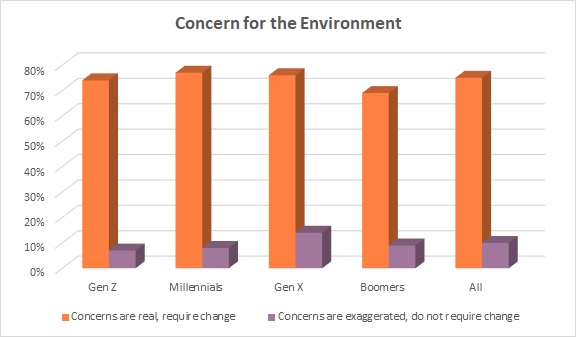Amid ever more extreme weather events due to climate change, consumers are faced with how they can make a difference, especially when it comes to what they purchase — and that includes apparel.
The effort, though, varies between generations, with research showing Millennials and, even more notably, Gen Z leading the charge toward a more sustainable future. At a combined 141 million population, these two generations represent a strong force for change. Yet, they’re still looking to brands to help the sustainability cause and provide them with better clothing choices.
YPulse’s MaryLeigh Bliss, chief content officer, says when it comes to Gen Z, Millennials, and sustainability, these generations live in somewhat of a conundrum.
“They’re not only thinking about the environment when they’re buying something. They’re also thinking about inflation and their own budgets. The majority tell us they wish they could buy eco-friendly products, but they can’t always afford them.
MaryLeigh Bliss, Chief Content Officer, YPulse
“On one hand, they care deeply about the environment and want to make a difference,” Bliss says in an interview with Lifestyle Monitor™. “But on the other, the clothes and styles they can afford are most likely those fast fashion retailers that are most harmful to the environment. YPulse’s Cause Conundrum trend research shows that while they try to buy products that are environmentally friendly, 76 percent of young people agree: ‘I don’t make enough money to always shop my values.’ The majority do shop from fast fashion brands, even though 64 percent of fast fashion shoppers agree, ‘Shopping fast fashion is bad for the environment.’ We found small, day-to-day efforts are the aim of Gen Z and Millennials. But when it comes to the large scale, they believe it’s corporations’ responsibility: 81 percent of young people agree ‘Corporations (e.g. companies, brands, etc.) should take more responsibility for fighting climate change.’
“Additionally, they’re not making purchasing decisions in a bubble,” Bliss says. “They’re not only thinking about the environment when they’re buying something. They’re also thinking about inflation and their own budgets. The majority tell us they wish they could buy eco-friendly products, but they can’t always afford them.”
This represents a major opportunity for fashion brands and retailers. Consider three-quarters (75 percent) of all consumers say concern for environmental change is real and requires change, according to Cotton Council International (CCI) & Cotton Incorporated’s 2021 Global Sustainability Survey. Millennials (77 percent), Gen X (76 percent), and Gen Z (74 percent) are significantly more likely than Boomers (69 percent) to feel this way. Taking it further, Millennials (65 percent) and Gen Z (62 percent) are significantly more likely than Gen X ( 54 percent) and Boomers (50 percent) to say sustainability and environmental concerns influence their clothing purchases.

Nearly three-fourths (72 percent) of Gen Z shoppers say it is important to them to do whatever they can to improve the environment, according to the 2021 Global Sustainability Survey. And 74 percent of Gen Z consumers say it is important that apparel products can return to the earth by being biodegradable/compostable. That compares to 63 percent of Millennials, 62 percent of Gen X, and 56 percent of Boomers.
Lee Jeans’ Charlie Alex, public relations coordinator, says it makes sense that Gen Z would be leading the charge when it comes to pulling companies into a sustainable future.
“Whether they want to or not, I think that’s where we’re lucky with Gen Z,” Alex says in an interview with Lifestyle Monitor™. “They have led the way for body positivity. They’ve led the way for gender neutral clothes. They’ve led the way for wearing something with confidence, whether it’s trendy or not. So, when it comes to sustainability, whether they want to or not, they kind of have to lead the way because they’re the ones that are going to be dealing with the climate crisis. They are not waking up and asking themselves, ‘Do I care about the climate or not? Do I care about sustainability or not?’ It’s just in what they do. And that’s partly why I think vintage and recycling is so important to them.”
The company has launched Lee Archives on its website, which offers periodic drops of true vintage, pre-owned pieces. Each item goes through a quality check and is cleaned before it is put up for “re-sale.” The vintage page promotes the Vintage Lee pieces “are more than stylish, they’re sustainable” and choosing a piece will both keep apparel out of landfills and give vintage clothing new life.
More than 1 in 4 consumers (26 percent) say they plan to buy more used/second-hand clothing in the future, according to the Cotton Incorporated 2022 Covid Survey (Wave 14) and Inflation & Supply Chain Survey (Wave 4) – U.S.
This also bears out in YPulse’s research that shows Gen Z and Millennials are helping to fuel the popularity of secondhand marketplaces.
“Thrift stores are in their top 10 ranking of favorite places to buy clothes, alongside those fast fashion behemoths,” Bliss says. “Second-hand shopping is also a top fashion trend they’re interested in, among both generations. This more sustainable shopping is a part of their behavior as well, and often motivated by their desire to buy sustainably when they can. YPulse’s research shows the majority (56 percent) would prefer to shop from a ‘slow fashion’ brand than a fast fashion brand — they just don’t always have the means.”
In another sustainability effort, Lee has also launched its For A World That Works program. It marks a company commitment that by 2025 Lee will power 100 percent of all owned and operated facilities with renewable energy, increase each year the use of Indigood-dyed products, which are dyed using 90 percent less water than conventional dyeing processes, utilize more than 50 percent sustainable fabrics and source 100 percent sustainably grown or recycled cotton.
Consumers overwhelmingly (87 percent) consider cotton/recycled cotton/organic cotton to be safe for the environment, according to the Global Sustainability Survey. That compares to recycled polyester (61 percent), Tencel (45 percent), rayon (42 percent), and nylon and polyester (both 39 percent). Brands should be aware that nearly two-thirds of Gen Z and Millennial consumers (64 percent) check labels, online descriptions or hangtags about the sustainability/environmental friendliness of a clothing item.
Bliss says YPulse gets a lot of questions from brands who struggle to understand data that shows young consumers have concerns about sustainability and climate change, yet they’re still buying fast fashion.
“For two generations who have experienced two enormous economic downturns as well as a pandemic in their young lives, budget is going to trump nearly everything else when it comes to the products that they buy,” Bliss explains. “However, our 2023 sustainability report found that their climate change anxiety and concern is as strong as ever. Most Gen Z and Millennial consumers (66 percent) worry about climate change on a monthly or even daily basis, and the majority (75 percent) agree that climate change is an immediate threat to human life.
“They’ve grown up watching the impacts of climate change in real time,” Bliss says. “Nearly a third tell us that their life has already been impacted by climate change, and 77 percent of young people agree, ‘It’s up to my generation to stop climate change from getting worse.‘ They are paying attention to what brands are doing and it continues to be really important for brands to make changes. Because they will be called out by these generations.“
